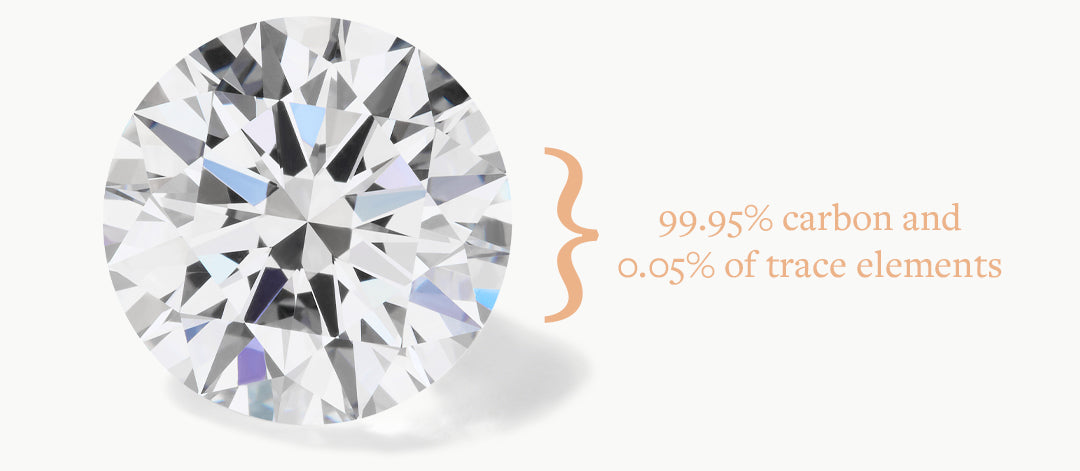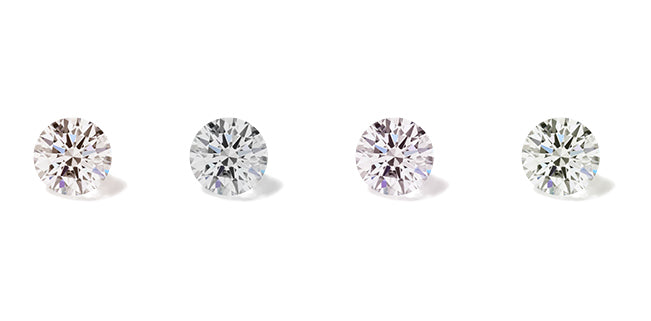What is a Lab Grown Type IIA Diamond?

It takes thousands of years for a mined diamond to form and develop, in contrast, a lab diamond has a much shorter growth cycle. However, aside from that, there's little to tell the two apart. With the same chemical make-up and unmistakable dazzle, both mined diamonds and lab diamonds remain in high demand.
TABLE OF CONTENTS
Understanding Diamond Type
If you're thinking of investing in a stunning stone, then it is worth learning more about diamonds. When we talk about diamond type, we're not referring to the shape or size, we are actually referring to a scientific classification determining the level or “type” of impurities the gem has.
The Chemical Make-Up of a Diamond
Diamonds are the only precious stones made almost entirely of just one element - carbon. The purest diamonds contain only carbon, but as we have previously mentioned, pure diamonds are very rare. Being one of the main group elements, diamonds are composed of around 99.95% carbon, with the remaining 0.05% comprising of trace elements, such as nitrogen. Trace elements can have an impact on the shape and color of the stone.

Measuring Impurities
Diamonds may look perfect, but very few are completely flawless. This goes for natural diamonds and lab diamonds.
Lab diamonds are Man-made, so Why are They Not Perfect?
As you may know, lab grown diamonds are created within closely monitored lab environments, with specific temperature and pressure settings. However, as with any process, random human errors could happen. Within a lab environment, there are instances when mineral impurities can enter the stone. The aforementioned reason is the reason why all lab grown diamonds are not perfect.
Atomic impurities versus Diamond Inclusions
In regards to diamond type--the diamond-type measures atomic impurities (those of which are the internal crystal lattice of carbon atoms). Let us not confuse atomic impurities with inclusions. Inclusions can be picked up with a powerful microscope, and if very obvious, can be visible with the naked eye. Whereas, atomic impurities cannot be seen with an eye or a microscope. Moreover, they can only be seen with an infrared spectrometer--as seen below. Once measured, the diamond is given a diamond type classification.
What is a Diamond Type IIa?
Also known as a diamond type 2a diamond, a Type IIa is one of four diamond classifications. Around 1-2% of all diamonds are classified as Type IIa (or 2a).
These gems are purely, or almost purely carbon, and are considered to be the purest and most valuable of all.
Type IIa diamonds have zero or exceptionally few nitrogen atoms within the crystal lattice structure. These diamonds can be completely colorless. However, some have a brown, light gray, pink or yellow hue.

Other Diamond Types: Type IIB, IA, and IB

Type IIB Diamond
Type 2b diamonds are nitrogen free, but contain boron. Boron tends to soak up yellow, orange and red light, which can result in the diamond emitting a very faint blue or grey hue.

Type IA Diamond
Most diamonds (around 98%) are classified as type 1a diamonds. This classification indicates that nitrogen atoms are clustered together inside the carbon lattice. Type 1a diamonds sometimes look colorless, but they tend to soak up blue light and can emit a very pale-yellow hue.

Type IB Diamond
Around only 0.1% of all diamonds are classified as type 1b. This classification is given if the nitrogen atoms are scattered around the carbon lattice rather than bunched together. Type 1b diamonds soak up blue and green light and look darker than type 1a diamonds - colors include brown, orange and yellow hues.
What About Green Diamonds?
Green lab diamonds take their color from certain treatments. Lab created green diamonds and other fancy colored lab stones, obtain pigment from beta and gamma rays while growing. Fancy green diamonds are the second rarest fancy color for natural diamonds. If a green diamond has no trace of brown or grey, the rarer it will be. The rarest are red natural diamonds--that's why some may purchase the lab-created alternative instead. Moreover, fancy natural diamond colors exist solely on the surface. Therefore, the color will fade over time.

Is Diamond Type Important?
You might have heard of the Four C's - Cut, Clarity, Color, and Carat. All are important factors when choosing a lab diamond engagement ring, or any other piece of diamond jewelry for that matter.
We could say the fifth “C” is the classification of diamond type. If you are keen on perfection, then a type IIa lab diamond is more than likely the ideal stone for you. However, you make the ultimate decision and determine how much emphasis you want to place on the purity of your diamond.
Buying a Type IIa Diamond
When you're choosing the perfect piece, take a good look at it by checking if the vendor offers IGI certification. This is an independent grading report issued by the International Gemological Institute (IGI). The report contains all the important features of your diamond--outlining its measurements and confirming its authenticity and quality.
The price of your diamond should reflect the IGI report findings. Type IIa diamond prices vary--you will pay much less for a lab grown type IIa synthetic diamond than a mined one. Other factors such as color lab diamond color> and clarity lab diamond clarity> also play their part in determining price e.g. a 'D color type IIa' diamond will be pricier than a 'K color type IIa' diamond. Our advice is to shop around to find the right gem for you, check the IGI report and do make sure you are getting a good deal.
FAQs
What is a Lab Grown Type IIA Diamond?
A lab-grown Type IIA diamond is a diamond that has been created in a laboratory using advanced technology. It is chemically, physically and optically similar to a natural diamond. Type IIA diamonds are considered to be the purest and most chemically perfect type of diamond. They are composed of pure carbon and have no impurities or structural defects.
Lab-grown Type IIA diamonds are created using one of two methods: High-Pressure High-Temperature (HPHT) or Chemical Vapor Deposition (CVD). In both methods, a small diamond seed is placed in a chamber where it is exposed to high pressure and high temperature or a chemical vapor. These conditions cause the carbon atoms to crystallize and grow into a diamond.
Lab-grown Type IIA diamonds are considered to be of the same quality as a natural Type IIA diamond, however, they are usually less expensive due to the manufacturing process being more efficient, and they also have the advantage of being ethically produced.
Do lab-grown diamonds also have inclusions?
What is a type IIb diamond?
Is certification important when buying a Lab Grown Type IIa diamond?
When buying a lab-grown Type IIa diamond, certification is important because it provides detailed information about the diamond's characteristics and quality. A certification from a reputable gemological laboratory confirms that the diamond has been thoroughly examined and graded according to established standards. It also provides a detailed report about the diamond's carat weight, measurements, color, clarity, and cut.
A certification also serves as a proof of authenticity, and it verifies that the diamond is indeed a lab-grown diamond and not a natural diamond that has been treated or altered in any way.









